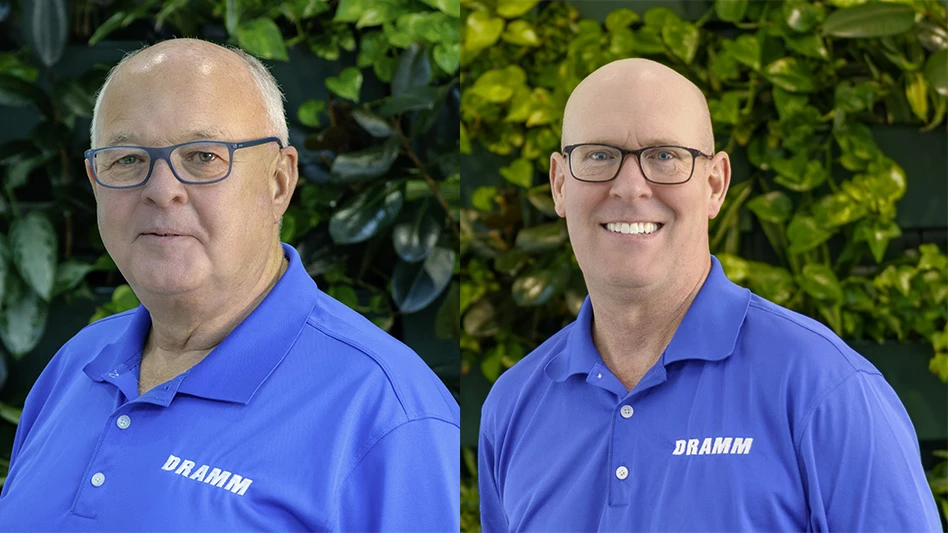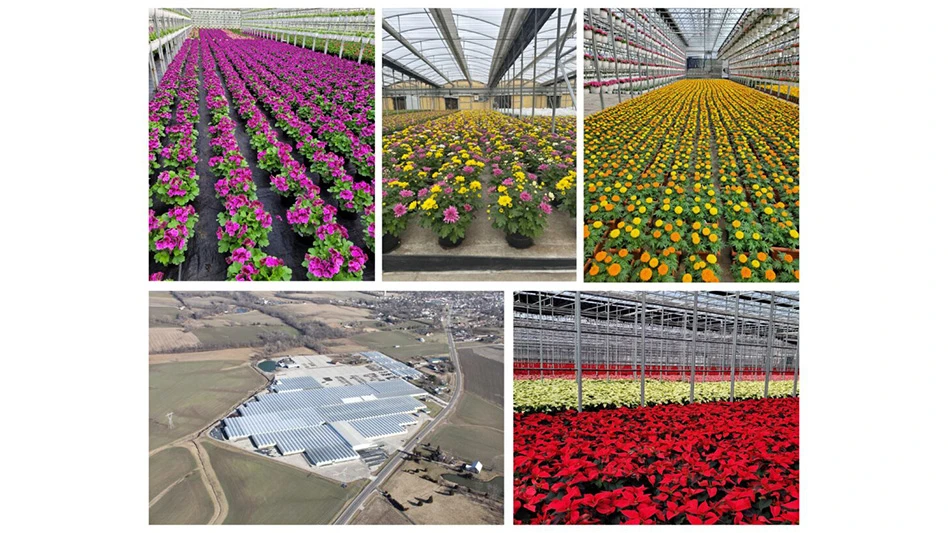
With the storied rivalry between Alabama and Auburn heating up just hours away, it’s no surprise that football analogies often find their way into discussions about spring planning in the heart of the South.
“Just like preparing for the big game, you have to plan,” says Todd Carnley, vice president of sales and marketing at Flowerwood Nursery, headquartered on 410 acres of production in Loxley, Alabama (which serves as its distribution and propagation hub), and with 100 acres of production in Mobile and 60 acres in Cairo, Georgia. “You play the game, and some things are going to work out really well, and some things you’re going to need to work on at practice next week or in the offseason. It’s that continuous improvement that makes you a little bit better every year.”
Flowerwood supplies major big box retailers like Lowe’s, The Home Depot and Walmart, as well as independent retailers and large-scale rewholesalers. Through its partnership with Plant Development Services, Inc. (PDSI), Flowerwood consistently introduces new plant varieties to the market.
“Heading into (2025), we can support an outrageously good spring with the plants we have right now,” Carnley says. “But if things are a bit softer, then we’re going to pivot and work a little bit harder to match our customers with the plants we have.”
Nursery Management talked to Carnley about market conditions, challenges and preparations for spring 2025.
NM: What market conditions are you forecasting for Spring 2025? What do you anticipate will be the most significant challenges you’ll need to overcome?
TC: Absolutely, market conditions are a primary challenge for us heading into this spring. We’re very much concerned about the economy and consumer health. So, we’ve looked at housing starts, which — as of September — were about 8 to 10% above where they were the previous year. While that’s a good sign, we do know consumers remain under stress with inflation. So, we need to make sure we’re delivering value to consumers at the end of the day.
Another challenge or concern is the weather. We grow primarily woody ornamentals, so the majority of our plants are outside. We do have some greenhouses, but we have to cover plants with cloth in the event of a severe freeze, which would slow some things down. And we’ve been fortunate that we’ve not experienced a severe freeze over the last few years. Nonetheless, a major concern is getting through the winter and what the weather looks like in the spring.
And hiring and (labor) retention are always a concern. While we use the H-2A program, it seems like the costs continue to increase for labor. So, while we feel good about our labor situation, we continue to work to try to control the costs associated with it.
NM: What preparations best position your operations for spring?
TC: We have a three-year production plan in place, and we have that broken down with quantity and a ready date. So, in other words, we know what the sales group is asking for on March or April 1, so it’s not ambiguous what we need for spring. Then our production team will take that and reverse engineer it. They will look at it and determine what’s required to have it ready on April 1.
The other thing we do is we have a lot of equipment that, at this point, requires maintenance. One innovative thing we do is we place Cannon [Equipment] racks — which are like four-by-four — on tractors. They fit on trailers, and they will lift up with pneumatics and lock on. When we pull the plants from the field, we put them on that rack, which takes them to our loading dock. Then we have grabbers that will grab it … when it’s time to ship that plant. So, a lot of time right now is spent making sure the wheels are working and that the tractors are in good condition.
The things we need to do to prepare for spring is a marathon, but spring is a sprint. It’s 100 days, if we’re lucky. Two to three of those weeks, everyone is stressed to the max. We just try to calm everyone down and remind them we can all take a breath at the finish line.
NM: What do you anticipate will be the biggest difference between Spring 2024 and Spring 2025?
TC: Last spring, we felt like the market may be softer (than in previous years). Early on, it wasn’t that way. We had a spectacular February, March and April, and then it tailed off hard in May, but we expected that.
So, I’d say the expectations for us are different for (spring 2025) than it was last spring. Spring is like a fingerprint ... no two are the same. It’ll be interesting to see what the weather has in store for us and if the stress of inflation starts to weigh on consumer spending. The key word I use with our team is you better be ready to pivot. Something is going to happen that we don’t expect, and you better have a flexible organization to make a lot of lemonade from the lemons you’re going to be given along the way. That’s why being part of an innovative company really helps you through the tough times.
NM: How does spring training impact your ability to pivot and be innovative?
TC: We have a mentorship program that we’ve used with a lot of our managers. We try to make sure they’re cross-trained and understand other tasks by other groups. It gives everyone an appreciation for what each other’s jobs are and those responsibilities.
And we hold a number of group meetings [in the spring] and review everyone’s specific disciplines. And we’ll talk about our customer base. We want everyone to understand what we’re doing and why we’re doing it. And it really all goes back to the consumer. We want [our employees] to understand what the consumer sees and what they’re looking for [in a plant]. It’s a lot of base training. And while we don’t view it as anything special, it pays dividends when you get into the heat of battle.
NM: Any new plants you’ll be bringing to market this spring that you’re excited about?
TC: One is a Better Boxwood. Boxwood blight has been decimating a lot of the old, established landscapes. [Plant Development Services Inc.] found a group based out of Belgium that has been working on boxwood breeding for the last 20 years. We did a soft release in the fall and we’ll be releasing that into the market in the spring.
The other is a Touch of Gold Holly. It’s a dwarf bright yellow Hoogendorn holly that is cold hardy to Zone 5. We’ve been very successful with Sunshine Ligustrum, but this is another option for a more dwarf, bright yellow plant that just brightens up the landscape. It can serve as a replacement for some annuals because you’re going to have that permanent color. They’re just as beautiful in November as they are in April.
NM: Launching new varieties like these really speaks to the importance of training and having a well-educated staff.
TC: I always tell our salespeople that part of their job is being a teacher and educating others about the new genetics [in these new plant varieties]. They need to be able to answer the why … Why is it better? Why should we carry it? Why would the consumer want it? If you have a good plan on how to answer those [questions] correctly, then you’re going to be successful.
NM: How have you managed plant shortages?
TC: With some of the plants that we’ve struggled to find on the open market, we have put those back into production. The pressure on [plant availability] – which has been a wonderful thing – has been incredible over the last four to five years. And we’ve found that the plants that we could not reliably purchase, we’ve had to grow.
And if we get to the point where we still need something, I always look for an acceptable substitute. For example, if you’re having trouble sourcing a Wintergreen Boxwood, then you may be able to use a Japanese or a Winter Gem boxwood. If we can’t find an August Beauty gardenia, we’ll use a Jubilation gardenia that’s in the Southern Living Program, which is similar … and they’re going to get more blooms out of the Jubilation. So, producing more and then looking for acceptable substitutes has been the key to staying ahead of the demand.
NM: What excites you about Spring 2025?
TC: If you’re not positive in this business, then you’re going to go home crying every night. I enjoy learning how consumers are going to react to these new plants we’re bringing to market this spring. Do they like them? Did they get excited? And if they don’t and you’re wrong, then fail fast. Take what you’ve learned, make an adjustment, and move on to the next thing.

Explore the January 2025 Issue
Check out more from this issue and find your next story to read.
Latest from Nursery Management
- GIE Media Horticulture Group wins five regional 2025 Azbee Awards of Excellence
- Get to know Pat Reilly with NewGen Boxwood and the American Boxwood Society
- Terra Nova Nurseries introduces rust-free and disease-resistant heucherella
- John T. Nickel, founder of Greenleaf Nursery Co., passes away at 89
- Three tours offered at 2025 Farwest Show
- Garden Media Group announces sixth annual Women in Horticulture Week
- Star Roses and Plants announces National Knock Out Rose Day
- The Growth Industry Episode 4: How federal budget cuts are affecting horticulture nonprofits





